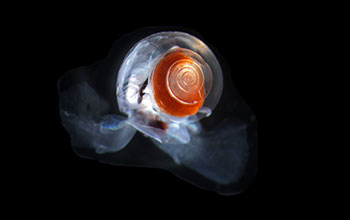Multimedia Gallery
Pteropod (Image 1)
A floating pteropod (from the Greek word meaning "wing-foot"), captured from the northeastern Pacific Ocean.
Drifting with currents in the open ocean, these tiny swimming marine snails are an important source of food for fish, whales and other marine animals. Also called "sea butterflies" because of their wing-like swimming appendages, pteropods build shells made of calcium carbonate, similar to those of garden snails but thinner and more delicate.
At the Woods Hole Oceanographic Institution (WHOI), scientist Gareth Lawson and colleagues are studying pteropods, investigating how these planktonic molluscs are being affected by ocean acidification. The world's ocean waters have gradually become more acidic. Ocean acidification is a direct consequence of increasing levels of carbon dioxide (CO2) in the Earth's atmosphere, brought on as a result of human-caused CO2 emissions. WHOI researchers are comparing pteropods in ocean regions with normal acidity to those in regions already showing acidification.
In addition to his research, Lawson collaborated with sculptor Cornelia Kavanaugh, whose sculptures of pteropods were shown in the exhibit "The Gorgeous Shapes of Sea Butterflies" at the Smithsonian Institution's National Museum of Natural History's Sant Ocean Hall. (Date of Image: Aug.-Sept. 2012) [Image 1 of 4 related images. See Image 2.]
Credit: Image courtesy of Nancy Copley; ©Woods Hole Oceanographic Institution
See other images like this on your iPhone or iPad download NSF Science Zone on the Apple App Store.
Special Restrictions: Use of this image for any purpose must be approved by the Woods Hole Oceanographic Institution media relations office first. Please contact the office by email, media@whoi.edu, or by telephone, (508) 289-3340.
Images and other media in the National Science Foundation Multimedia Gallery are available for use in print and electronic material by NSF employees, members of the media, university staff, teachers and the general public. All media in the gallery are intended for personal, educational and nonprofit/non-commercial use only.
Images credited to the National Science Foundation, a federal agency, are in the public domain. The images were created by employees of the United States Government as part of their official duties or prepared by contractors as "works for hire" for NSF. You may freely use NSF-credited images and, at your discretion, credit NSF with a "Courtesy: National Science Foundation" notation.
Additional information about general usage can be found in Conditions.
Also Available:
Download the high-resolution JPG version of the image. (223 KB)
Use your mouse to right-click (Mac users may need to Ctrl-click) the link above and choose the option that will save the file or target to your computer.

